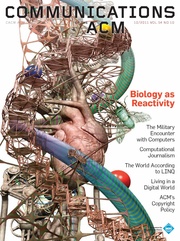ACM Comm 2011 10 Biology as Reactivity (Notes)
|
Biology as Reactivity |
Biology as Reactivity
Exploring the connection of biology with reactive systems to better understand living systems. Applying reactive systems studied in computer science to biology.
People
Ideas
- A reactive system is characterized by the way it responds to its inputs, as they arrive over time, sequentially, or concurrently.
- The system’s behavior and outputs are not just a function of the input values but also of the order in which the inputs arrive, their arrival times, speeds, and locations, and so forth.
- Complex reactive behavior is difficult to comprehend because it is neither predominantly computation-rich nor primarily data-intensive, and does not yield well to techniques based on algorithmics, mathematics, and data management. Rather, reactive systems “live” (if we may use a pun in an article on biology) in order to react.
- Parallel has several different definitions in Computer Science
- Clock Synchronous - Execution proceeds in lockstep with a global clock, as sequential discrete steps, with each building block (component) of a system contributing one action during each time unit.
- Interleaved Asynchronous - Each action represents the contribution from a single component, but different actions, possibly carried out at different time rates, may represent different components.
- Bounded Asynchrony - Allows the system components (for example, cells) to proceed independently while bounding the differences in their rates.
- Towers of Abstraction - Abstraction layers one atop the other until the phenomenon under study is simulated to an acceptable level.
- Cohen and Harel, 16 “A major goal of systems biology is to learn how the concurrent reactions and interactions of the lower-scale components of a cell, organism, or society generate emergent properties visible at higher scales and higher layers of reality.“
- Inheritance is a behavior inherited through biological or social means.
- Noise and choice. Stochasticity has received much attention in systems biology, as numerous experimental studies have reported the presence of probabilistic mechanisms in cellular processes. Random determinations are made kinetically. Things banging into each other. Since the collisions always vary in numbers, timing, and nature, the biological process, while always starting under the same conditions, will always and inevitably, produce different outcomes. While these difference maybe functionally identical, there are still observable differences.
- Stochasticity Stochastic[1] Something that was randomly determined.
- The temporal evolution of the system [biological reactions] can be described by a continuous-time Markov process, 37 which is usually represented as a system of ordinary differential equations (ODEs) called the chemical master equation (CME).
- There exists no theory to model this. So state ranges are used. This makes meaningful predictions impossible.
- From simulation to verification. While simulation generates one behavior of a model at a time, verification looks systematically at the set of all possible behaviors. In short, "How does a stochastic system, which produces a different outcome each time, will produce something useful all the time?" How can that be verified?
- Popperian
- Turing Test
- Reactive Animation
- Reactive Model Deficiencies - genericity and linkage.
- Horizontal Linkage refers to compositionality—the ability to compose side-by-side parts of the desired model into a whole, which is a particular challenge when the individual parts have different execution semantics, an issue that is central also to embedded-systems design.
- Vertical Linkage is related to abstraction, and is the ability to link higher levels of the model with lower levels, for example, models of the intracellular pathway and network information with models of the reactive intercellular effects.
- Completeness "If it is successful, the system stands, which does not mean that it is correct: it simply means that we have not yet found the next bug (and we should keep trying, by making the model/specification more complete)." Ah, no. The system is correct IF it behaves according to the specification, verification, AND behaves as intended, validation. Any subsequent bug found are then cosmetic and not material. The system is, by providence, limited to something humans can build. Not some theoretically perfect system.
References
- Biocharts - Kugler, H., Larjo, A. and Harel, D. Biocharts: A visual formalism for complex biological systems. J. Royal Society Interface, 2010.
- A Cell Succeeds By Being Robust And Resilient. Cohen, I.R. and Harel, D. Explaining a complex living system: Dynamics, multi-scaling and emergence. J. Royal Society Interface 4, (2007), 175-182.
- Reactive Systems Harel, D. and Pnueli, A. On the development of reactive systems. In Logics and Models of Concurrent Systems. K.R. Apt, ed. NATO ASI Series, Vol. F-13, Springer-Verlag, NY, (1985), 477-498.
- Bounded Asynchrony. Fisher, J., Henzinger, T.A., Mateescu, M. and Piterman, N. Bounded asynchrony: A biologically-inspired notion of concurrency. In Proc. of FMSB ’08 Cambridge, UK.
- Pi-Calculus Milner, R. Communicating and Mobile Systems: The pi-Calculus. Cambridge University Press, Cambridge, UK, 1999).
- Process Algebra Milner, R. A Calculus of Communicating Systems. Springer Verlag, 1980
- Reactive Animation Dill, D.L., Knapp, M.A., Gage, P., Talcott, C., Laderoute, K. and Lincoln, P. The pathalyzer: A tool for analysis of signal transduction pathways. In Proc. 1st Annual Recomb Satellite Workshop on Systems Biology, 2005.
- Temporal Logic Pnueli, A. The temporal logic of programs. In Proc. Symp. Found. Computer Science, (1977) 46-57.
Internal Links
Parent Article: Reading Notes
